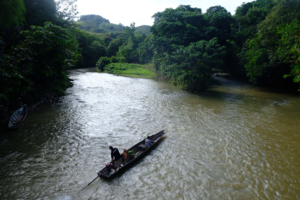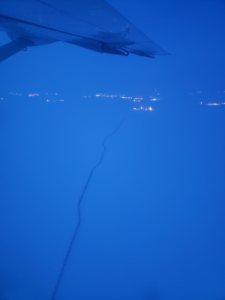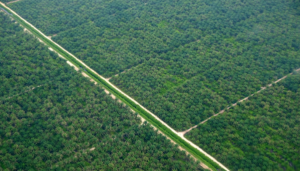Earlier this year, I carried out fieldwork with the support of the RSA in Malaysian Borneo and on Alaska’s North Slope as part of my project investigating the impacts of land tenure on Indigenous land use decisions. In Malaysia, the rights of Indigenous Peoples are largely customary, meaning they are not formally codified into law. In contrast, Alaska Natives’ rights to land and resources were spelled out in the 1971 Alaska Native Claims Settlement Act (ANCSA). All aboriginal land claims in Alaska were extinguished in exchange for nearly $1 billion and 17.8 million hectares of land, while hundreds of Native regional and village corporations were established to manage the transferred funds and lands. While ANCSA remains controversial to this day, in the years since the settlement, Alaska Natives have been able to reap the financial rewards of resource development on their lands, especially on Alaska’s oil-rich North Slope.
Borneo and Alaska might seem worlds apart, but even before touching down in Asia’s largest island, I noticed parallels with America’s 49th state. As the plane descended into Miri – a coastal city boasting high-rise hotels and glitzy malls – I glimpsed a defunct oil rig perched on a hill. Nicknamed the “Grand Old Lady,” the structure was Royal Dutch Shell’s first in the country. “Oil Rig No. 1,” as it’s more formally known, jumpstarted Malaysia’s massive oil industry, whose continued growth into the 21st century is exemplified by the Petronas Towers dominating the capital of Kuala Lumpur.
Eight years later in 1917, Shell geologists began exploring Alaska, whose economy has similarly grown on the backs of the petroleum industry. Shell’s efforts eventually led the British-Dutch multinational to begin prospecting for offshore oil in the icy waters of the Chukchi and Beaufort Seas in the 1980s. The techniques and processes of oil exploration initially refined in the archipelagic region of Southeast Asia – specifically, the oil-rich countries of Malaysia, Indonesia, and Brunei – thus played a role in leading Shell to the Arctic. Nevertheless, the oil industry has taken divergent pathways in Borneo and Alaska due to differences in Indigenous Peoples’ legal rights and ways of life.
In the village I visited on Borneo in the Malaysian state of Sarawak, which was largely inhabited by the forest-dwelling Penan people, I met several individuals who had gone off to work in Malaysia’s offshore oil industry. After saving some cash, they’d return home, using their earnings to buy a house in Miri or expand their village accommodations – typically airy longhouses sitting next to a meandering creek or river. To the Penan, the offshore oil industry does not interfere with the trees and waterways that are their lifeblood. Fossil fuel extraction is so out of sight, out of mind that its negative impacts on the environment may be literally unimaginable. When I asked one individual about his hopes for future development, he expressed that he would like to see the oil industry expand to Penan lands: “It’s not destructive, anyway, if you could concentrate on the one little hole and go down. It doesn’t harm the land. That one would be nice, but for now, I’d rather not see drilling going on because all the revenue will go to somebody else and leave my people again.”

A river runs through the jungle in Long Lamai, Sarawak, Malaysia. Photo: Mia Bennett.
On Alaska’s North Slope, many of the native Iñupiat do favour drilling both because they view their traditional practices as able to coexist alongside industry, and also because the institutional framework keeps many of the revenues within local communities. Thanks to ANCSA, a significant proportion of revenues from oil extraction funnel into Native communities (Huskey, 2018) although there are heated debates over the fairness of the distribution of those revenues. Soon after ANCSA, Iñupiat leaders also pushed to establish their own municipal government, the North Slope Borough, which is able to tax the oil industry. In turn, these taxes subsidize modern schools and developments like the impressive Iñupiat Heritage Center in Utqiaġvik, the North Slope’s largest settlement. Each year, whaling crews prepare their boats at the center, which also hosts permanent displays celebrating the region’s rich history. One individual said to me, “We need development to continue because we don’t want our culture to go extinct.”

Women sewing together sealskins for an umiak (skin boat) in the lead-up to the bowhead whaling season. Photo: Mia Bennett.
To some individuals, then, traditional livelihoods have come to depend on the oil industry. This idea might seem paradoxical, but in a way, even though the extraction of fossil fuels causes myriad negative impacts on the environment and health, ANCSA and the North Slope Borough’s taxation powers have together helped ensure that at least some of the benefits of extraction stay within the community.
Back in Borneo, when I asked one Penan activist what he thought the biggest threat to his people’s land rights was, he responded, “The law itself.” Its lack of clarity allows regulations to be manipulated to undermine Penan rights, even customary ones, he elaborated.
Even in Alaska, however, laws that help locals capture the proceeds of resource development can have pernicious effects. ANCSA has contributed to higher social inequality and unsustainable resource development in places like Southeast Alaska, where the old growth temperate rainforest has been clear-cut (Dombrowski, 2007). In my own encounters, one young man recounted – with enthusiasm rather than sadness – memories of how the oil well where he worked was where his grandparents had been born many decades ago, when it was just tundra.

The Trans-Alaska Pipeline crossing the North Slope, with oil wells in the background. Photo: Mia Bennett.
In both Borneo and Alaska, development has arrived. Neither the Penan nor the Iñupiat will return to their nomadic ways. Networks of pipelines cover the Alaskan tundra, while in Borneo, gridded oil palm plantations run right up against the rough edges of the dense, tangled jungle. Still, despite development, the land continues to hold special meaning. One Penan man described, “To me, the land is much more than the timber. It’s a culture, its music to the soul and it also sort of scenery that you can draw for yourself. It’s a lifeline for the Penan.” Ensuring that the people who live on the land maintain the right to draw the scenery for themselves, so to speak, and realize the futures they envision – whether or not development is involved – critically depends on strong legal frameworks.

Oil palm plantations outside Miri, Sarawak, Malaysia. Photo: Mia Bennett.
Nevertheless, laws that promote the local accumulation of capital from resource extraction may enhance support for and hasten the very processes of development that reconfigure people’s relationship to the land. As Indigenous Peoples gain more rights around the world (O’Faircheallaigh, 2013), their relationship to the land and the law will undoubtedly change. Examining the consequences of these shifts to the legal and environmental landscapes will require further research conducted in partnership with local communities, with results compared across regions (e.g. Haley, 2004). Asia and the Arctic are far apart, but comparing the experiences of Indigenous Peoples in the face of global resource development may spotlight successful policies and practices that can potentially be transferred across continents.
References
Dombrowski, Kirk. 2007. “Subsistence Livelihood, Native Identity and Internal Differentiation in Southeast Alaska.” Anthropologica 49(2): 211–29.
Haley, Sharman. 2004. “Institutional Assets for Negotiating the Terms of Development: Indigenous Collective Action and Oil in Ecuador and Alaska.” Economic Development and Cultural Change 53(1): 191–213.
Huskey, Lee. 2018. “An Arctic Development Strategy? The North Slope Inupiat and the Resource Curse.” Canadian Journal of Development Studies / Revue canadienne d’études du développement 39(1): 89–100.
O’Faircheallaigh, Ciaran. 2013. “Extractive Industries and Indigenous Peoples: A Changing Dynamic?” Journal of Rural Studies 30: 20–30. http://linkinghub.elsevier.com/retrieve/pii/S0743016712000873 (June 27, 2017).
Mia Bennett is an assistant professor in the Geography Department and School of Modern Languages & Cultures (China Studies Programme) at the University of Hong Kong
Twitter: @cryopolitics
Are you currently involved with regional research, policy, and development, and want to elaborate your ideas in a different medium? The Regional Studies Association is now accepting articles for their online blog. For more information, contact the Blog Editor at RSABlog@regionalstudies.org.